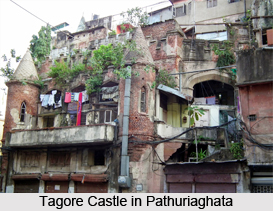 Pathuriaghata is an urban area in northern part of Kolkata. This place was once the hub of Bengali cultural zamindar.
Pathuriaghata is an urban area in northern part of Kolkata. This place was once the hub of Bengali cultural zamindar.
Location of Pathuriaghata
Pathuriaghata was located in the Indian state of West Bengal.
Residential Area of Pathuriaghata
Pathuriaghata is one of the oldest residential areas in what was Sutanuti. Once the abode of the Bengali rich, the neighbourhood and its surrounding areas are now dominated by Marwaris. Even in the 21st century the area is replete with colonnaded mansions.
Bengali People of Pathuriaghata
In Pathuriaghata the oldest and most renowned resident of the neighbourhood were the Tagores. Joyram Tagore, who amassed a large fortune as a merchant and as Dewan to the French government at Chandannagar, shifted from Gobindapur to Pathuriaghata, when the British constructed new Fort William in mid eighteenth century. The more prominent amongst those who stayed in Pathuriaghata were Hara Kumar Tagore Prasanna Kumar Tagore, Jatindramohan Tagore and Prodyot Kumar Tagore. Prasanna Kumar Tagore built a huge mansion in Naptehata and named it "Palace". People used to call it "Tagore Palace". Prasanna Kumar Tagore modelled the building on that of an English castle. It even had a 100 feet (30 m) high centre tower in the fashion of Windsor Castle in England.
Tagore Castle of Pathuriaghata
Tagore Castle had an auditorium and the Tagores patronised Banga Natyalaya, from 1859 to 1872. It was started by Jatindra Mohan Tagore and his brother Shourendra Mohan Tagore, both ardent theatre enthusiasts. The first play staged here was Kalidas" Malavikagnimitram in Sanskrit, in July 1859.
Mullick Family of Pathuriaghata
Pathuriaghata has the next to the turrets of Tagore Castle on Prasanna Kumar Tagore Street where the house of the Mullick family, topped by classical statuary is located. Three large structures have already come up next to these; one of them is the Burrabazar branch of Metropolitan School, established in 1887. Jadulal Mullick had numerous contributions in social and law spheres. At one time he donated enormously to the Oriental Seminary from where he had passed Entrance, school-leaving examination.
Related Articles:
Kolkata
West Bengal, Indian State
Tourism in Kolkata
History of Kolkata



















